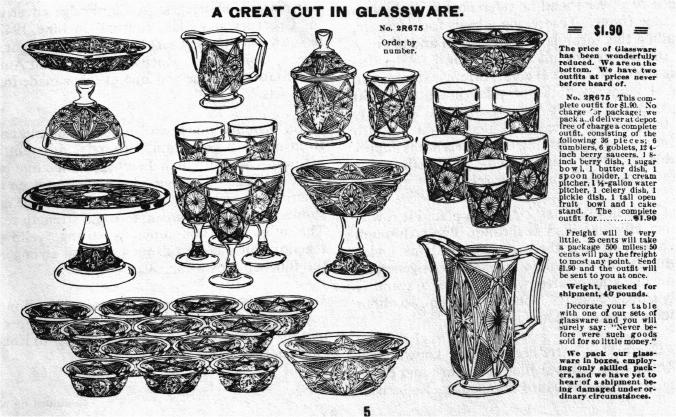The History of Cambridge's Pattern #2510
by Dr. James S. Measell
Issue No. 78 - October 1979
In the 1903 Cambridge Glass Company catalog, a pressed ware pattern designated #2510 is shown in the four-piece table set. The purpose of this brief article is to document the history of this rather interesting pattern, which was probably intended to simulate cut glass when it was first conceived and manufactured.
This pattern was first introduced in January, 1898, by Central Glass Company of Summitville, Indiana, who called it simply "No. 98". Mrs. Kamm mistakenly attributed the pattern to the Central Glass Company of Wheeling, West Virginia (Kamm, VII, p. 13), an entirely different firm. The Summitville-based company was relatively modest, having just 17 pots, but they advertised their new No. 98 pattern in China, Glass and Pottery Review for several months, using the covered butter dish and the covered sugar bowl as illustrations. Insofar as I know, only clear glass was made at the Central firm in Summitville.
In late 1899, the Central Glass Company was one of some 19 glass factories brought together under the aegis of National Glass Company, which had its headquarters in Pittsburgh. Within six months, the National had closed down the Summitville factory, and the moulds there were probably shipped to the nearby Indiana Tumbler and Goblet Works at Greentown, another National concern, albeit much larger than the Central plant. Both clear and transparent blue glass were made in this pattern at Greentown, for the late Dr. Ruth Herrick found many, many fragments when she dug at the Greentown site in the 1950's. A number of different items were made, and Sears Roebuck catalogs for both 1901 and 1902 illustrated the variety of articles in this assortment. All are known in both clear and blue glass.
Between 1901 and June, 1903, the Greentown plant was running around the clock virtually without shutdowns to meet customer demand for its Chocolate glass and, in 1903, its Golden Agate (Holly Amber) glass. They probably made the pattern under discussion here in clear and blue glass only as long as the market warranted.
The Indiana Tumbler and Goblet Works was destroyed by fire on June 13, 1903. Whether or not any moulds survived the fire is uncertain, but the National frequently moved moulds from factory to factory, so the moulds for this pattern may have been moved to the National's Cambridge plant before the fire at Greentown. In any event, when pattern #2510 was advertised from Cambridge in 1903, it already had quite a history, indeed.
Except for Kamm's remarks about this pattern (VII, p. 13), the only other early pattern glass researcher to mention it is Millard (Goblets II, p. 75). He calls it "Brazen Shield". Although the name is more distinctive that descriptive, I have continued to use it in my new book "Greentown Glass: The Indiana Tumbler and Goblet Company".

